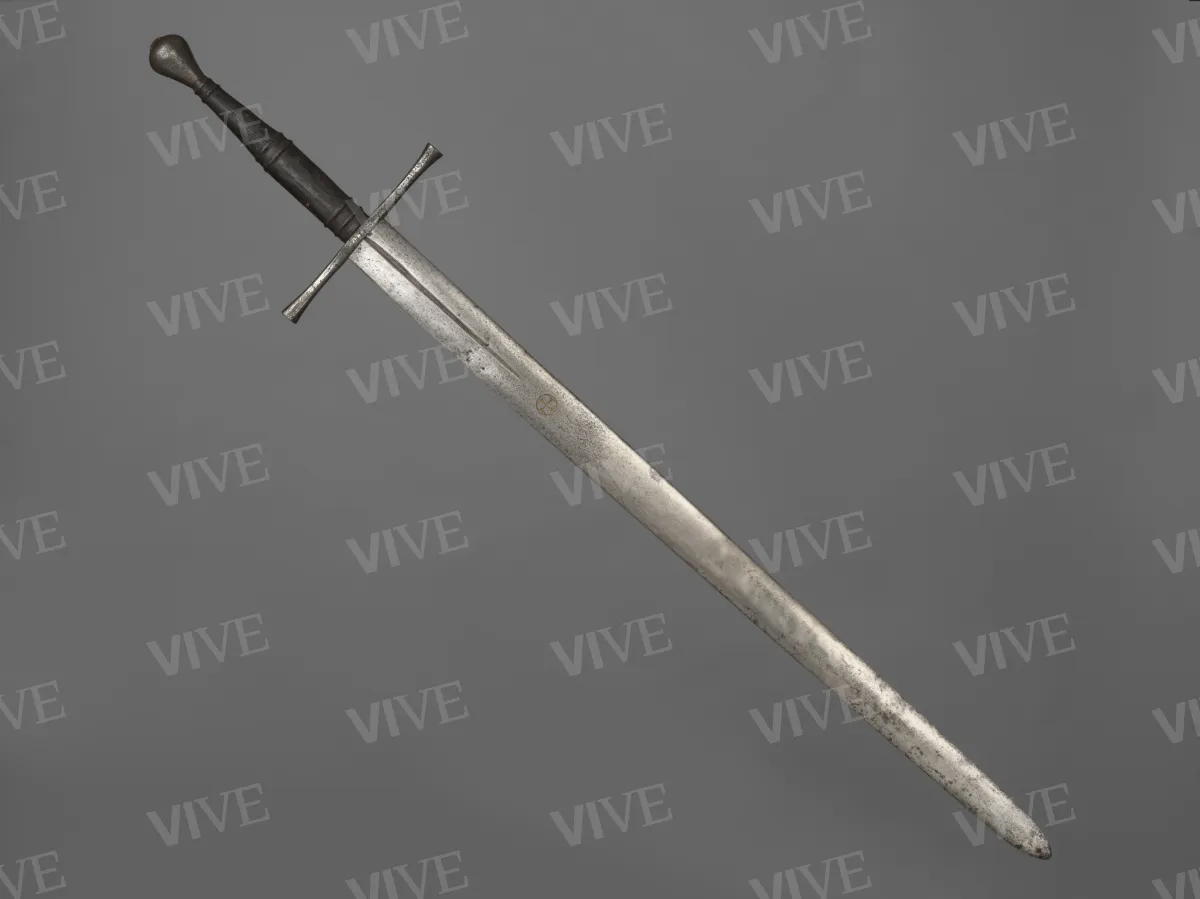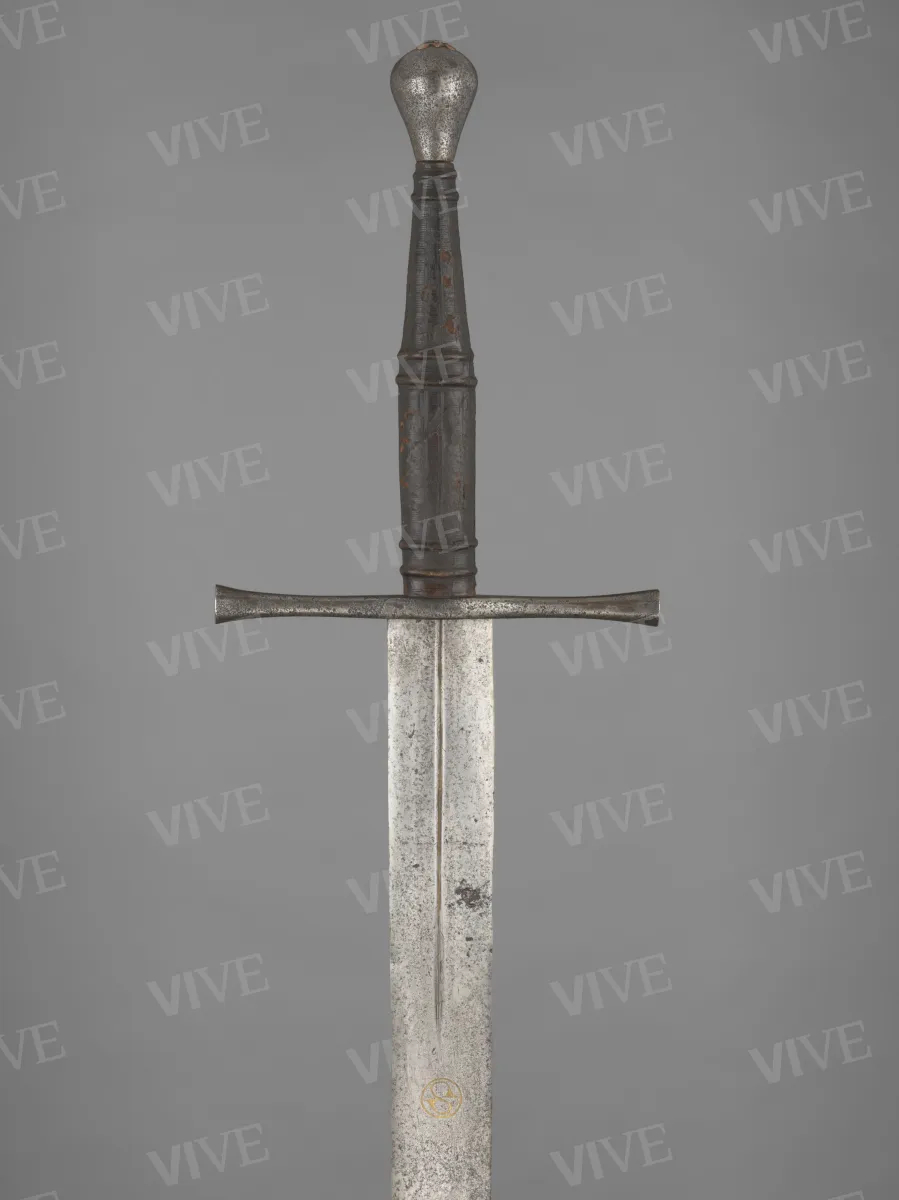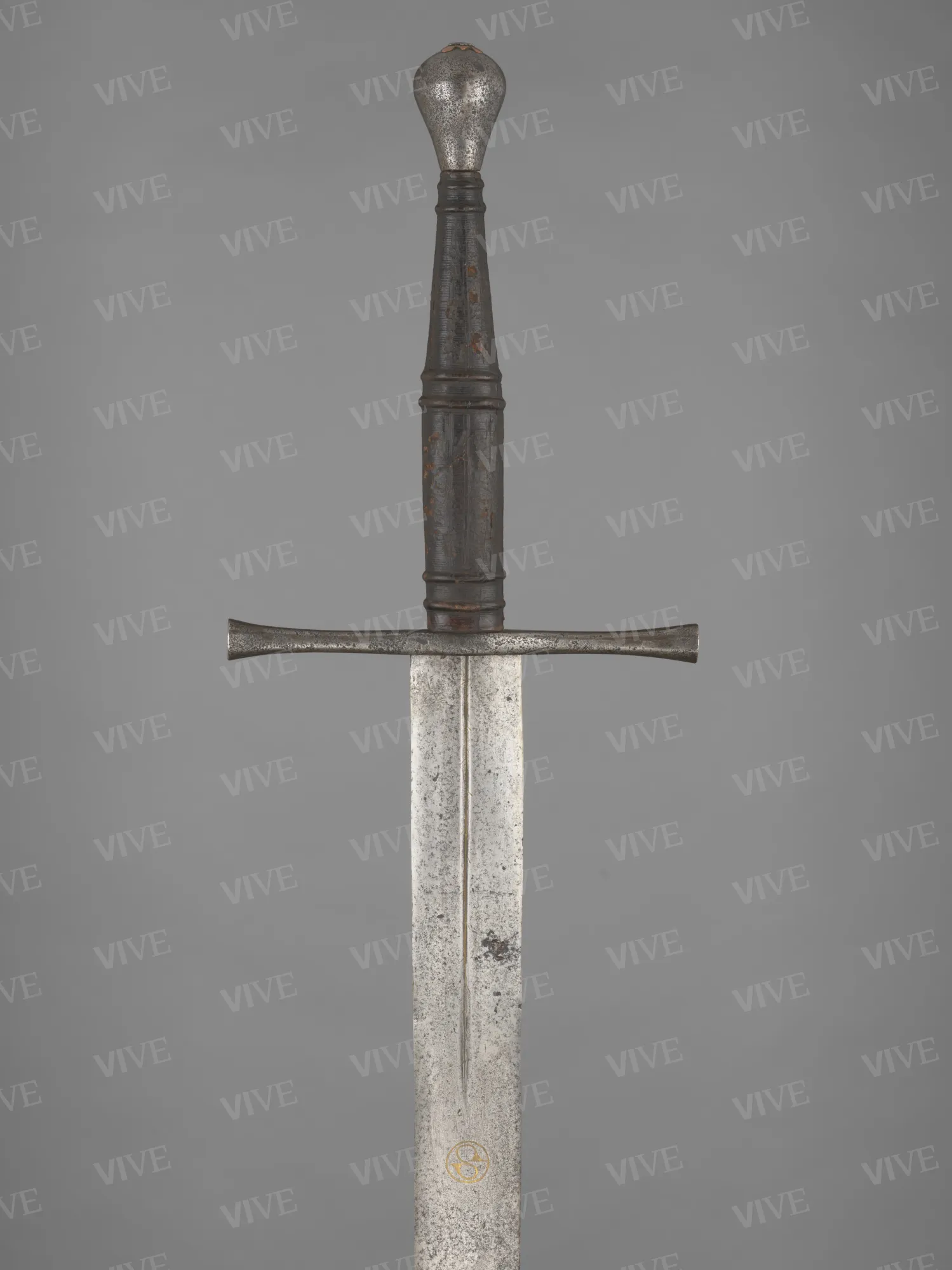Spadona
German production 1480–1510
This bladed weapon is known as a spadona due to its large size and is believed to have been used as a "sword of justice" for executions. It was not easily handled in battle but was particularly effective for cutting because of its sharp blade. The museum also houses the original leather sheath that protected the handle when the weapon was placed into the scabbard.
This bladed weapon is known as a spadona due to its large size and is believed to have been used as a "sword of justice" for executions. It was not easily handled in battle but was particularly effective for cutting because of its sharp blade. The museum also houses the original leather sheath that protected the handle when the weapon was placed into the scabbard.
Details of work
Catalog entry
The spadona features a long triangular blade with a fuller in the forte, the section closest to the hilt, whose length corresponds roughly to that of the handle. In the deepest part of the hollow, there is a copper inlay, a thin line with outward-facing designs, which are purely decorative and without practical function, intended to improve the aesthetics of the weapon. On the blade, at the end of the hilt, two inlaid marks are visible, one on each side: a Greek cross inscribed in a circle and a letter “S,” also inscribed in a circle. These decorations are created using the agemina technique, which involves engraving the iron to create hollow parts to be filled with copper.
The upper part of the sword features a thin hilt with straight branches that slightly thicken outward, a leather sleeve with thin stripes for better grip, and a pear-shaped pommel with a copper flower-shaped stud. The preserved leather sheath protects the cross-guard when inserted in the scabbard (di Carpegna 1969, p. 35, n. 199).
This broadsword, also known as a great sword, is particularly robust and features a very rigid blade. Its characteristics suggest it may have been intended as a “sword of justice” or used for executions, as the flat blade is optimized for clean cuts rather than versatile combat. The short hilt, which provides minimal protection during combat, further supports this hypothesis (Scalini 2018, p. 59, n. I.13; Oakeshott 2021, pp. 146–150).
Likely produced in Germany between the late fifteenth and early sixteenth centuries, this weapon features a barely legible stamp on the blade, possibly a shield, indicating the workshop where it was forged. The blade also bears two larger, more distinct agemini symbols which may have been requested by the client to mark their possessions. These same symbols (a cross and an S) are present on another sword housed at Palazzo Venezia (inv. 11826; di Carpegna 1969, p. 35, n. 195), which is almost identical to this one in terms of both blade and hilt, differing only in the shape of the pommel, which is round rather than pear-shaped.
The simplified design of the hilt, along with the striped leather sleeve and pear-shaped pommel, allows this broadsword to be compared to a similar piece housed in the Wallace Collection in London (inv. A698; Mann 1962). This comparison suggests it may originate from a German workshop and is dated to the early sixteenth century.
The sword housed in the Palazzo Venezia, along with its counterpart, is part of the collection owned by Prince Ladislao Odescalchi (1846–1922). This collection was acquired by the Italian State in 1959 and subsequently placed in the Palazzo Venezia in 1969. Rather than being a family armory, this extensive collection was the result of intentional acquisitions made by Prince Odescalchi in both national markets (Florence, Rome) and international markets (Paris, London) beginning in the late nineteenth century (Barberini 2007).
Giulia Zaccariotto
Entry published on 27 March 2025
State of conservation
Good.
Coats of arms, emblems, and marks
The blade features two copper inlaid marks: a cross and a curved “S” inscribed within a circle. Additionally, near two-thirds of the hilt, there is an almost illegible stamp in the shape of a shield.
Provenance
Collezione Ladislao Odescalchi (Odescalchi, n. 540);
acquired by the Italian State, 1959;
Rome, Museo Nazionale di Palazzo Venezia, 1969.
Exhibition history
Rome, Museo Nazionale di Palazzo Venezia, Antiche armi dal sec. IX al XVIII. Già Collezione Odescalchi, May–July 1969;
Rome, Museo Nazionale di Castel Sant’Angelo;
Rome, Museo Nazionale di Palazzo Venezia, Armi e potere nell’Europa del Rinascimento, July 26–November 11, 2018.
References
Mann James Gow, European Arms and Armour. Wallace Collection Catalogues, 2 voll., London 1962;
di Carpegna Nolfo (a cura di), Antiche armi dal sec. IX al XVIII. Già Collezione Odescalchi, catalogo della mostra (Roma, Museo Nazionale di Palazzo Venezia, maggio-luglio 1969), con schede a firma del curatore, Roma 1969, p. 35, n. 199;
di Carpegna Nolfo, Le armi Odescalchi, Roma 1976;
Barberini Maria Giulia, La collezione Odescalchi di armi antiche: storia della raccolta del principe Ladislao, in «Bollettino d’arte”, s. VI, XCI, 2006 (2007), 137/138, pp. 101-114;
Fossà Bianca, Studio conservativo delle armi e armature Odescalchi. Nuove metodologie per la schedatura di una collezione, in «Bollettino d’arte», s. VI, XCI, 2006 (2007), 137/138, pp. 115-142;
Oakeshott Ewart, European Weapons and Armour. From the Renaissance to the Industrial Revolution, Woodbridge 2012;
Scalini Mario (a cura di), Armi e potere nell’Europa del Rinascimento, catalogo della mostra (Roma, Museo Nazionale di Castel Sant’Angelo; Roma, Museo Nazionale di Palazzo Venezia, 26 luglio-11 novembre 2018), con schede a firma del curatore, Cinisello Balsamo 2018, p. 59, n. I.13.














